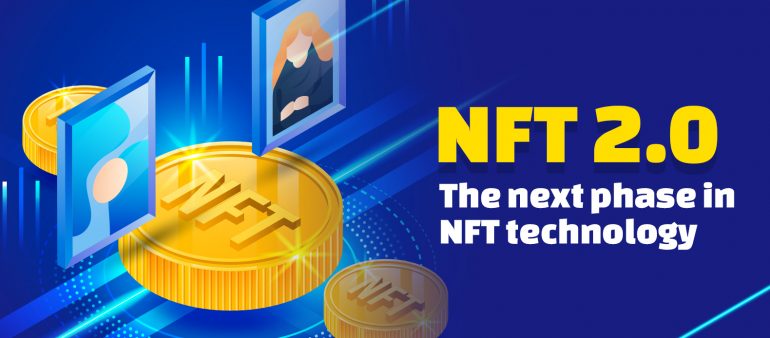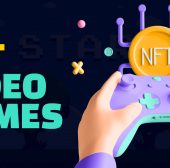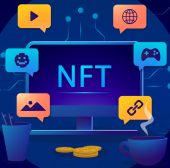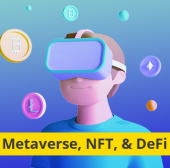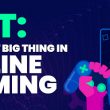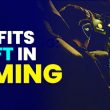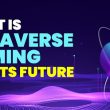Since NFT took the world by storm in 2021, they progressed beyond JPEG collectibles to establish themselves as a force in the crypto as well as Web 3.0 world. They have evolved into valuable assets with numerous applications in both the virtual and physical worlds. But now, the NFT era has been rising to its next better version with the introduction of NFT 2.0. NFT 2.0 represents an upgrade or evolution of the original NFT concept, incorporating the latest advancements and increasing utility in the existing NFT systems. This new form of NFT is expected to surpass the capabilities of its predecessor and offer even more exciting possibilities.
What is NFT 2.0?
NFT 2.0 is closely related to the first version of NFTs. In fact, NFT 2.0 operates seamlessly with NFT 1.0, incorporating the existing NFT infrastructure with new capabilities. NFT 2.0 can be viewed as an extension of NFT 1.0 rather than a completely new concept. While NFT 1.0 allows ownership of unique tokenized digital assets, NFT 2.0 broadens the possibilities by creating a new digital asset market with enhanced utilities (NFT use cases). Also, the most recent version of the NFT allows its owners to do more with their tokenized items. It enables players to interact and play around with their acquired digital assets. These assets can range from rare digital artwork to in-game objects, music, in-game items, tickets and other digital items.
But, apart from an increasing number of use cases, what distinguishes NFT 2.0? Let’s look at what differentiates NFT 2.0 from the previous form of NFT.
What differentiates NFT 2.0 from NFT 1.0?
Generativity
The ability to generate algorithmic randomness in tokenized digital assets is known as generativity. With it, players can pick an NFT that best fits their use case. Moreover, AI can incorporate customization to better meet the needs of NFT users. Let’s take a scenario to see how generativity works in NFT.
Assume you have three devices: One device that supports video, another with text and audio support and a third device that displays JPEGs. The latest version of NFT enables players to combine multiple assets into a single entity. Algorithmic randomness can be used to determine which content is suitable for every device as it retrieves it. This means video NFT will play on the video device, music NFT will play on the music device, etc.
Composability
NFT 1.0 only allows unique digital assets to be bought and sold on exchanges, but it is not possible to customize an asset. NFT 2.0 allows modifying an asset in order to develop a new customized asset. Metadata, artwork, and additional resources are all examples of changes. So, composability opens up to explore new possibilities for collectors by combining various assets together.
Interactivity
Another notable aspect of NFT 2.0 is interactivity. Interactivity makes it possible for current NFTs to automatically execute any changes made to them and any other NFTs that are part of it. By incorporating smart contracts into each NFT, they become smart and intelligent to take input from users and other sources. The inclusion of smart contracts into the current NFT infrastructure equips the NFTs with the power to do more than existing NFTs. Also, based on the owner’s preferences, NFTs can do a wide range of tasks, including sending commands, equipping other NFTs, altering their look, and more.
Experientiality
The experiential property of NFT 2.0 consists of the three features mentioned above, which collectively capture an authentic user experience. Consider collectible ticketed events as NFTs that provide the holder with advanced utilities. Alternatively, creating NFTs in response to how the user interacts with the application. In addition to many other industries, the gaming sector is keen to adopt NFT 2.0.
You may also read: NFT benefits for game owners and players
NFT 2.0 Abilities
The new version of NFT will have the following abilities:
Nested NFTs: NFT 2.0 enables infinite nesting of assets. This means that one NFT can be owned by other NFTs, which can further own other NFTs, and so on. Virtual exhibitions, games, conferences and artwork use nested NFTs.
Smart NFTs: NFT 2.0, unlike its previous version, enables smart contracts to be linked to NFTs. Thus, when NFT ownership is transferred, the smart contract will instantly update asset ownership data and record it on the blockchain. The smart contract guarantees the NFT developer receives a royalty when the asset is traded.
NFT rental model: NFTs can be rented out, which can result in passive income for the owner. It consistently enhances liquidity and makes NFTs smarter, more adaptive and trustworthy for users.
Personalized NFTs: In NFT 2.0, every token can be associated with a variety of designs and appear on a unique platform. This is in contrast to NFT 1.0, in which there was only one format that was displayed to everyone.
Co-owned NFTs: NFT 1.0 allowed only one company to be the legal owner of a given asset. However, with NFT 2.0, multiple owners can take part and hold a piece of non-fungible tokens. The asset’s and its owner’s trustworthiness improves when there are numerous owners.
Multi-resource NFTs: NFT 2.0 has the possibility to connect with multiple resources such as video, image, art, audio and so on.
The bottom line
If 2022 was a big year for NFT sales and hype, this year, 2023, and beyond can be even more significant as the industry reaches a major technological landmark. Looking at each feature and ability, you can already see the huge potential of NFT 2.0. The advent of this new iteration opens the gates to a new world, indicating additional opportunities and new use cases. Learn more about NFT and blockchain technology with Logic Simplified. For any suggestions or queries, contact us or drop us an email at enquiry@logicsimplified.com.
 Get a Quote
Get a Quote

